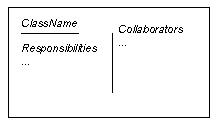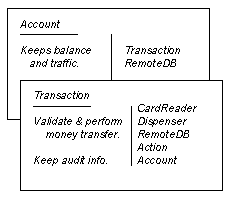CSC/ECE 517 Fall 2011/ch4 4i aa: Difference between revisions
| Line 15: | Line 15: | ||
*"Responsibilities identify problems to be solved." | *"Responsibilities identify problems to be solved." | ||
*"Collaborators are objects which will send or be sent messages in the course of satisfying responsibilities." [1] | *"Collaborators are objects which will send or be sent messages in the course of satisfying responsibilities." [1] | ||
Beck and Cunningham use 4 x 6 inches index cards because they are "cheap, portable, readily available, and familiar." [1] | Beck and Cunningham use 4 x 6 inches index cards because they are "cheap, portable, readily available, and familiar." [1] | ||
The physical spacial arrangement of the cards can have informal meaning: | The physical spacial arrangement of the cards can have informal meaning: | ||
| Line 23: | Line 25: | ||
*also cards representing parts are usually placed below the card representing the whole | *also cards representing parts are usually placed below the card representing the whole | ||
*"refinements of an abstraction can be collected and handled as a single pile of cards with the most abstract card on top where it can represent the rest."[1] | *"refinements of an abstraction can be collected and handled as a single pile of cards with the most abstract card on top where it can represent the rest."[1] | ||
Beck and Cunn.. "suggest driving a design toward completion with the aid of execution scenarios. We start with only one or two obvious cards and start playing "what-if". If the situation calls for a responsibility not already covered by one of the objects we either add the responsibility to one of the objects, or create a new object to address that responsibility. If one of the object becomes too cluttered during this process we copy the information on its card to a new card, searching for more concise and powerful ways of saying what the object does. If it is not possible to shrink the information further, but the object is still too complex, we create a new object to assume some of the responsibilities." [1] | Beck and Cunn.. "suggest driving a design toward completion with the aid of execution scenarios. We start with only one or two obvious cards and start playing "what-if". If the situation calls for a responsibility not already covered by one of the objects we either add the responsibility to one of the objects, or create a new object to address that responsibility. If one of the object becomes too cluttered during this process we copy the information on its card to a new card, searching for more concise and powerful ways of saying what the object does. If it is not possible to shrink the information further, but the object is still too complex, we create a new object to assume some of the responsibilities." [1] | ||
According to the experience of Beck and Cunn.. "When designers pick up a card they seem to more readily identify with it, and are prepared to deal with the remainder of the design from its perspective. It is the value of this physical interaction that has led | |||
Beck and cunn.. "encourage designers to pick up the card whose role they are assuming while "executing" a scenario and stress the importance of creating objects not to meet mythical future needs, but only under the demands of the moment. This ensures that a design contains only as much information as the designer has directly experienced, and avoids premature complexity." [1] | |||
According to the experience of Beck and Cunn.. "When designers pick up a card they seem to more readily identify with it, and are prepared to deal with the remainder of the design from its perspective. It is the value of this physical interaction that has led Beck and Cunn.. to resist a computerization of the cards." | |||
We are going to evaluate some computerizations of the cards keeping in mind that these tools may not provide the same user experience and ultimately the same design results as physical cards. | We are going to evaluate some computerizations of the cards keeping in mind that these tools may not provide the same user experience and ultimately the same design results as physical cards. | ||
Revision as of 16:28, 16 October 2011
CRC Card Tools
Introduction
"CRC cards were invented to document collaborative design decisions."[1]
CRC cards is a way to:
- Discover classes
- Determine the responsibilities of each class
- Describe the relationships among the classes
The information for each class is written on a separate card. [from our lecture notes]
- "The class name of an object creates a vocabulary for discussing a design."
- "Responsibilities identify problems to be solved."
- "Collaborators are objects which will send or be sent messages in the course of satisfying responsibilities." [1]
Beck and Cunningham use 4 x 6 inches index cards because they are "cheap, portable, readily available, and familiar." [1]
The physical spacial arrangement of the cards can have informal meaning:
- when cards overlap it can mean that the objects represented by the cards are collaborating.
- a card placed above another card can mean that the object it represents is supervising the object represented by the card below.
- also cards representing parts are usually placed below the card representing the whole
- "refinements of an abstraction can be collected and handled as a single pile of cards with the most abstract card on top where it can represent the rest."[1]
Beck and Cunn.. "suggest driving a design toward completion with the aid of execution scenarios. We start with only one or two obvious cards and start playing "what-if". If the situation calls for a responsibility not already covered by one of the objects we either add the responsibility to one of the objects, or create a new object to address that responsibility. If one of the object becomes too cluttered during this process we copy the information on its card to a new card, searching for more concise and powerful ways of saying what the object does. If it is not possible to shrink the information further, but the object is still too complex, we create a new object to assume some of the responsibilities." [1]
Beck and cunn.. "encourage designers to pick up the card whose role they are assuming while "executing" a scenario and stress the importance of creating objects not to meet mythical future needs, but only under the demands of the moment. This ensures that a design contains only as much information as the designer has directly experienced, and avoids premature complexity." [1]
According to the experience of Beck and Cunn.. "When designers pick up a card they seem to more readily identify with it, and are prepared to deal with the remainder of the design from its perspective. It is the value of this physical interaction that has led Beck and Cunn.. to resist a computerization of the cards."
We are going to evaluate some computerizations of the cards keeping in mind that these tools may not provide the same user experience and ultimately the same design results as physical cards.
Tools
Stickies
QuickCRC
Visual Paradigm for UML
Conclusion
"Because the designs are so much more concrete, and the logical relationship between objects explicit, it is easier to understand, evaluate, and modify a design.
We were surprised at the value of physically moving the cards around. When learners pick up an object they seem to more readily identify with it, and are prepared to deal with the remainder of the design from its perspective. It is the value of this physical interaction that has led us to resist a computerization of the cards.
The need to retain the value of physical interaction points to the need for a new kind of user interface and programming environment as far beyond what we have today as our current systems are beyond the tool-oriented environments of the past." [1 Beck/Cunningham]
References
[1] Beck/Cunningham
[2] CRC Cards: An Agile Thinking Tool
[4] Hot Draw
[5] HyperCard
[6] HyperCard Group
[7] SuperCard
[8] MetaCard
[9] MetaCard Group
[10] Revolution
[11] PhytonCard
[12] FreeCard
[13] FreeCard Group
Aldo [14] Visual Paradigm for UML
Aldo [15] QuickCRC
[17] CRC Card Editor
Aldo [18] Stickies on Mac

